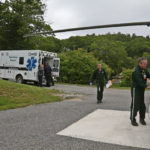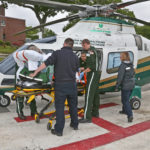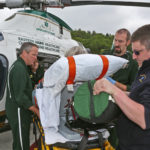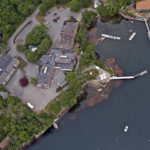BOOTHBAY HARBOR, Maine—The Boothbay Region Lions Club recently hosted LifeFlight of Maine’s development director, Amy Root, who shared a presentation titled, “Your Flying Hospital.” Since the local hospital closed, area residents rely more heavily on Boothbay Region Ambulance Service and LifeFlight in serious emergencies. The club has supported LifeFlight previously and invited the organization to provide an update on both fundraising efforts and patients served in the area.
The presentation highlighted LifeFlight’s role in Maine’s emergency medical system, including critical care transport of patients suffering from trauma, cardiac and stroke emergencies, and other serious illnesses and injuries. As healthcare becomes more regionalized across the state, local ambulance services and LifeFlight’s statewide critical care transport service become increasingly important, and rely even m
ore on private funding.
In LifeFlight’s case, patients and insurance companies are billed for services provided. These rates, however, are among the lowest charged by air ambulance organizations across the country and don’t quite cover the cost of operating the aircraft. Funding for capital expenses like additional aircraft and specialized medical and aviation equipment comes entirely from individuals, corporations and foundations.
The community of Boothbay has shown support for LifeFlight in a variety of ways, including donations from the Lions Club, the Rotary Club and several local businesses. The Railway Village hosted an educational reception, which led, in part, to an increase in contributions from individuals and families from the area. On September 10, the Boothbay Harbor Country Club is hosting a charity golf tournament to support LifeFlight.
Currently, LifeFlight is raising money to purchase a third helic
opter, a fixed wing airplane and all of the medical equipment needed for each of these aircraft. Donations from community and civic groups like the Lions and Rotary Clubs will go directly toward the purchase of the night vision goggles needed for the third helicopter. It will cost about $50,000 to outfit the new aircraft with military-grade goggles.
Night vision technology, implemented by LifeFlight more than 6 years ago, greatly increases both the safety and the reliability of every flight we make after sunset. This typically accounts for more than 40% of our flights each year, keeping our crew and more than 500 patients safe and sound.
LifeFlight of Maine is an independent 501(c)(3) non-profit air medical and critical care transport organization. LifeFlight helicopters, flying at 165 miles per hour, bring lifesaving critical care professionals and equipment directly to the patient. It also provides advanced emergency medical training to Maine’s hospitals, emergency medical services (EMS) and public safety agencies. Overseen by 21 physicians, LifeFlight cared for more than 1,600 critically ill and injured patients last year. Since its inception in 1998, LifeFlight has transported more than 18,000 patients from every hospital and nearly all of Maine’s communities and islands.




